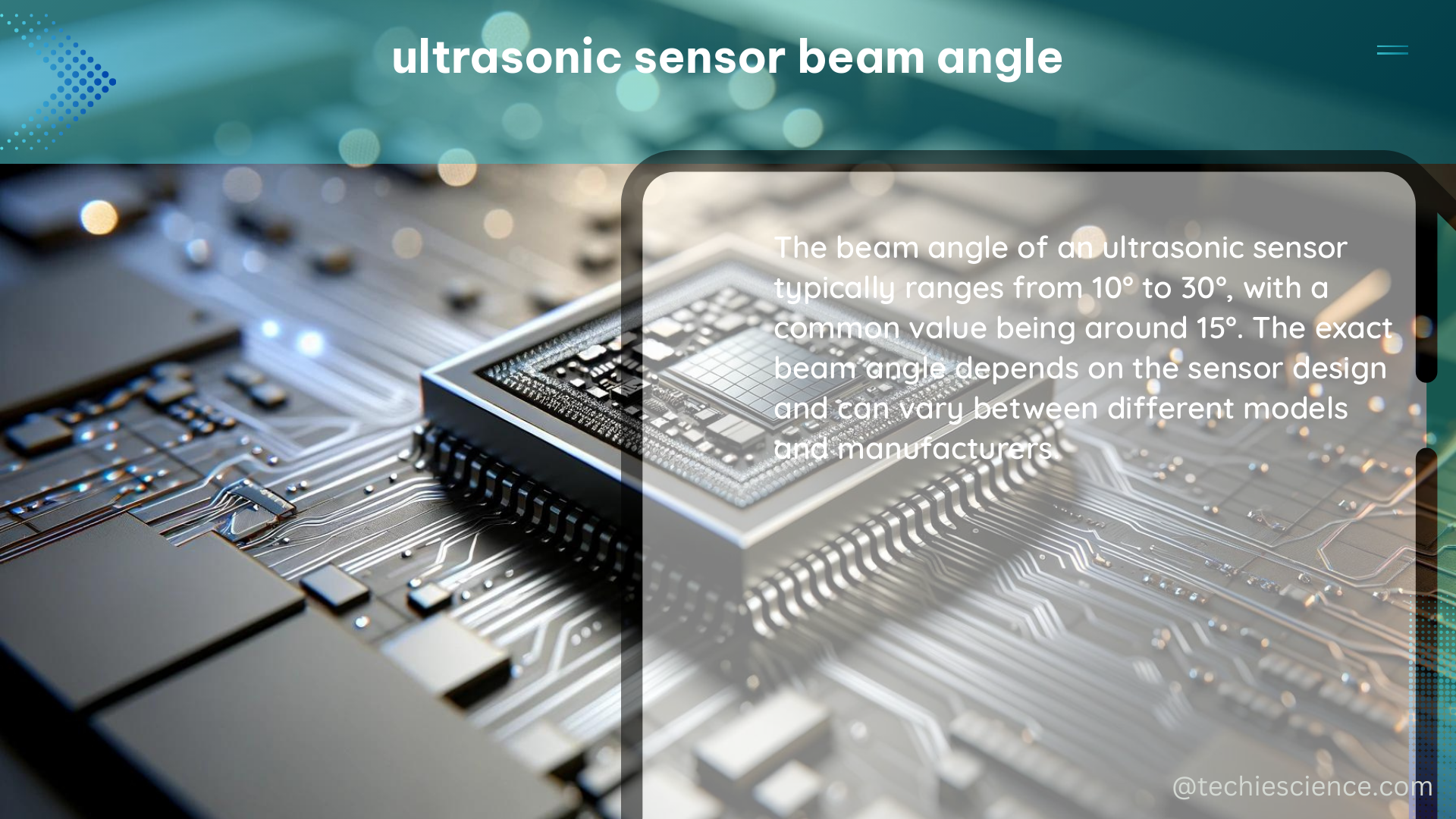The ultrasonic sensor beam angle is a crucial factor to consider when selecting an ultrasonic sensor for a specific application. The beam angle determines the width of the cone-shaped region within which the sensor can accurately detect objects, making it a critical parameter for precision distance measurements and targeted object detection.
Understanding Ultrasonic Sensor Beam Angle
Ultrasonic sensors work by emitting high-frequency sound waves and measuring the time it takes for those waves to reflect off an object and return to the sensor. The beam angle, also known as the field of view (FoV) or detection angle, is the angular width of the cone-shaped region within which the sensor can effectively detect objects.
The beam angle is typically measured in degrees, with a smaller angle indicating a more focused and concentrated detection area. A narrower beam angle provides higher precision distance measurements, as the sensor is less susceptible to interference from nearby objects or surfaces. Conversely, a wider beam angle results in a larger detection area but may compromise the accuracy of distance measurements.
Factors Affecting Ultrasonic Sensor Beam Angle

Several factors can influence the beam angle of an ultrasonic sensor, including:
-
Sensor Design: The physical design and construction of the ultrasonic sensor, such as the size and shape of the transducer, can affect the beam angle. Sensors with smaller transducers generally have a wider beam angle, while larger transducers tend to produce a narrower beam.
-
Frequency: The operating frequency of the ultrasonic sensor also plays a role in the beam angle. Higher-frequency sensors (e.g., 40 kHz) typically have a narrower beam angle compared to lower-frequency sensors (e.g., 20 kHz).
-
Acoustic Impedance: The acoustic impedance of the materials used in the sensor’s construction can impact the beam angle. Sensors with materials that have a higher acoustic impedance, such as ceramics, tend to have a narrower beam angle.
-
Acoustic Lens: Some ultrasonic sensors incorporate an acoustic lens, which can be used to shape and focus the sound waves, resulting in a narrower beam angle.
Selecting the Appropriate Beam Angle
When choosing an ultrasonic sensor for a specific application, it’s essential to consider the required beam angle based on the application’s needs. Here are some guidelines to help you select the appropriate beam angle:
-
Precision Measurements: If you require highly accurate distance measurements, a sensor with a narrower beam angle (e.g., 2-10 degrees) is generally preferred. This ensures that the sensor is less susceptible to interference from nearby objects or surfaces, providing more precise readings.
-
Wide Area Coverage: For applications that require a larger detection area, such as presence detection or obstacle avoidance, a sensor with a wider beam angle (e.g., 30-60 degrees) may be more suitable.
-
Specific Targeting: If you need to target a specific object or area within a larger detection zone, a sensor with an adjustable or selectable beam angle can be beneficial. This allows you to fine-tune the sensor’s detection area to your specific requirements.
-
Environmental Factors: Consider the operating environment of the sensor, as factors such as temperature, humidity, and the presence of obstacles or reflective surfaces can affect the beam angle and the sensor’s overall performance.
Ultrasonic Sensor Beam Angle Specifications
When researching and comparing ultrasonic sensors, pay close attention to the manufacturer’s specifications regarding the beam angle. Typical beam angle specifications include:
| Sensor Model | Beam Angle (degrees) |
|---|---|
| TFMini | 2.3° |
| VL53L1X | 25° |
| MaxSonar HRXL | 8° |
| MaxSonar SCXL | 30° |
| HC-SR04 | 15° |
| SRF05 | 30° |
It’s important to note that the beam angle specifications may vary depending on the sensor model, manufacturer, and the specific measurement conditions.
Practical Considerations and Applications
In the context of the Arduino forum post, the user was looking for an ultrasonic sensor with a very narrow beam angle to measure the height of box columns in a pallet without interference from adjacent columns. The user considered the MaxSonar HRXL / SCXL sensors but found that they still had an approximate 30 cm “error” due to the beam angle.
The VL53L1X and TFMini sensors were suggested as potential alternatives due to their narrow field of view (FoV) and long-range capabilities. The TFMini, in particular, has a very narrow FoV of 2.3°, which can provide precise distance measurements even at 12 meters. The TFMini can also operate in single trigger mode, which provides more control and allows the sensor to run cooler and use less power compared to continuous operation.
Other practical applications where a narrow beam angle ultrasonic sensor may be beneficial include:
- Robotic navigation and obstacle avoidance
- Level sensing in tanks or silos
- Proximity detection in industrial automation
- Precise distance measurements in construction and surveying
- Parking assist systems in vehicles
By understanding the importance of the ultrasonic sensor beam angle and selecting the appropriate sensor for your application, you can ensure accurate and reliable distance measurements, targeted object detection, and enhanced performance in a wide range of DIY and industrial projects.
References:
- Ultrasonic sensor with very narrow beam – Arduino Forum. https://forum.arduino.cc/t/ultrasonic-sensor-with-very-narrow-beam/609189
- Understanding the Basics of Ultrasonic Sensors – Industry Articles. https://www.allaboutcircuits.com/industry-articles/understanding-the-basics-of-ultrasonic-proximity-sensors/
- How to Choose the Best URM Ultrasonic Sensors for Your Project. https://www.dfrobot.com/blog-13411.html
- TFMini Datasheet. https://www.sparkfun.com/datasheets/Components/Sensors/Proximity/TFMINI-Datasheet.pdf
- VL53L1X Datasheet. https://www.st.com/resource/en/datasheet/vl53l1x.pdf
- MaxSonar HRXL/SCXL Datasheet. https://www.maxbotix.com/documents/HRXL-MaxSonar-WRC_Datasheet.pdf

The lambdageeks.com Core SME Team is a group of experienced subject matter experts from diverse scientific and technical fields including Physics, Chemistry, Technology,Electronics & Electrical Engineering, Automotive, Mechanical Engineering. Our team collaborates to create high-quality, well-researched articles on a wide range of science and technology topics for the lambdageeks.com website.
All Our Senior SME are having more than 7 Years of experience in the respective fields . They are either Working Industry Professionals or assocaited With different Universities. Refer Our Authors Page to get to know About our Core SMEs.